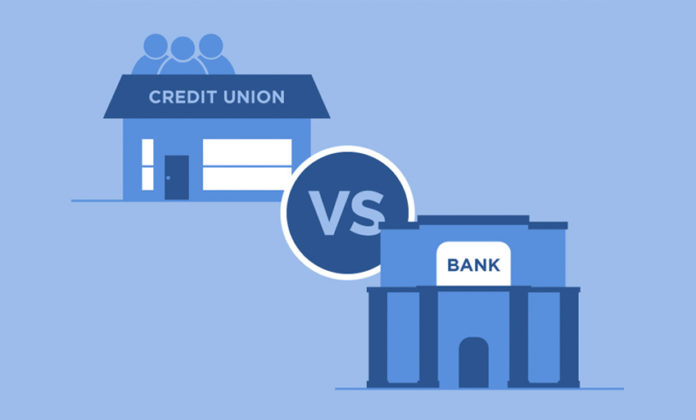Over 93% of Americans have some type of financial transactional account, including checking, savings, money market, and call accounts. However, despite desiring a variety of choices in order to make informed decisions for their families and businesses, most Americans choose large national and regional banking institutions for their financial needs. In fact, big banks account for 74.8% of the total financial account market while smaller banking institutions and credit unions account for only 18.2% and 7%, respectively.
Why the disparity? Although credit unions have been providing financial services in the U.S. for over 100 years, many people simply don’t know how they differ from a typical bank. The popularity of credit unions exploded in the first half of the 20th century and especially during the Great Depression. During this time, consumer credit from banking institutions was tight, leading many Americans to demand alternative banking choices. Credit unions were more likely to approve “risky” loans and provide services to people with less-than-perfect credit. Credit unions gained so much popularity that President Franklin Roosevelt enacted the Federal Credit Union Act in 1934, which established the National Credit Union Administration (“NCUA”) in order to better regulate federal credit unions and insure money deposited into credit union accounts.
Credit unions and banks have a variety of major and minor differences, which boil down to business structure, product offerings, customer service, and membership requirements. These differences may be viewed as advantages or drawbacks, depending on your financial needs and preferences.
Credit Union Business Structure
One of the most important and major differences between banks and credit unions is business structure. A bank – whether it’s a small local provider or a national chain – is a for-profit enterprise. Similar to any other for-profit business, banks want to increase sales while reducing costs. If a bank is a public company, it’s governed by a board of directors and sells shares of its stock to investors.
Conversely, credit unions are member-owned not-for-profit cooperatives. Specifically, if you open any type of account at a credit union, you’re considered a part-owner of that union. As such, credit union members enjoy certain benefits such as the ability to elect a volunteer board in charge of making important decisions on services, fees, and overall credit union management. Members also benefit from profit sharing in the form of reduced fees and dividends. As a result, credit unions typically consist of small, independent businesses or local chains.
Credit Union Customer Experience
When it comes to customer service, credit unions outrank other financial institutions. According to the most recent annual American Customer Satisfaction Index (“ACSI”) report, credit unions scored an 85 for customer satisfaction, while the average bank scored a 76. The ACSI measured a variety of factors, including expectations, quality, value, loyalty, and complaint rates. Credit unions have outscored banks on all major factors for seven consecutive years.
What makes credit unions so customer friendly? The reasons relate not only to their lower product rates and fees, but also to how they operate. As small not-for-profit cooperatives serving the local community, credit unions are more likely to work with people with poor or no credit that have been turned down by larger banks to obtain loans. Furthermore, some credit unions that serve low-income populations quality for the NCUA low-income designation, which entitles them and their members to additional benefits. In addition, credit unions work toward the betterment of their members and the surrounding community by offering a variety of local supports, such as sponsoring neighborhood or town projects, offering personal finance classes, providing microloans to people or businesses that don’t qualify for more traditional loans, and even offering scholarships and grants for local students.
Credit Union Products
Similar to shopping at a large national big-box retailer versus a small mom-and-pop store, banks and credit unions provide similar financial benefits – but the products and types of services can be significantly different. Banks, especially large, national chains, generally provide more products – such as a variety of checking and saving account types, CDs, IRAs, and even credit cards. The variety allows individuals and businesses to find what works best for them.
Credit unions, on the other hand, don’t always have the resources to offer the product variety that a larger bank could. However, as they are not-for-profit organizations, credit unions are able to offer lower fees and higher interest rates on the products they do carry as compared to a traditional bank.
In addition to fewer product offerings, credit unions typically do not offer the same amenities as banks. With advanced online and mobile banking options, remote check deposits, and ubiquitous branches and ATMs – there’s a reason why banks control 93% of the financial account market. Quite simply, banks have the resources and economy of scale to invest in state-of-the-art, convenient services that customers want.
Conversely, as credit unions are dedicated to serving a small, local population, there are typically only a few branches. Most credit unions do not maintain the capital to invest in cutting-edge services, and typically only offer rudimentary online banking options. However, although individual credit unions do not maintain a large number of branches, many credit unions belong to larger cooperatives that share resources, such as ATMs. This is especially important for today’s banking customer that requires on-the-go convenience and access to free ATMs.
Credit Union Membership Requirements
Lastly, a major difference between credit unions and banks is membership requirements. As mentioned, credit unions are member-owned and operated cooperatives, while banks are either private or public business enterprises. Banks are open to the public, and are free to do business with whomever they want. Credit unions, on the other hand, are required by law to restrict membership to certain communities tied by a “membership field” based on common occupations or association membership, family ties, or location. Most credit unions base their membership on locality, such as a town or region, while others may only serve certain professions, such as teachers or those in law enforcement.
The NCUA changed its field of membership regulations in 2003 in order to increase credit union membership. The new rules expand what constitutes an occupational common bond as well as a community. The new regulations also eliminated several mandatory factors determining common bonds and membership fields. This has allowed credit unions that were once relatively inaccessible to open their doors to more types of consumers.
Bottom Line
Credit unions are enjoying increased interest in the wake of the recession and amidst consumer backlash against “too big to fail” banks. In 2011, a grassroots movement capitalized on feelings of consumer unrest by promoting Bank Transfer Day, urging Americans to move their accounts from big, national banks to community banks or credit unions. While over 600,000 people reportedly made the switch on Bank Transfer Day, the much-publicized movement continued to gain momentum. Approximately 5.6 million people moved their bank accounts in the fourth quarter of 2011, of which 11% was attributed to the Bank Transfer Day movement. Since that time, interest in credit unions has continued to gain momentum. Credit union membership increased 3.5% in 2015, the fastest annual advance since 1994.
As with any decision, there are advantages and disadvantages to choosing either institution for your financial needs; it’s important to consider your needs, lifestyle, and goals. For example, an individual running a small consulting firm who regularly travels internationally may opt for a large bank due to its plethora of technology amenities and international presence. Conversely, the owner of a local shop may choose a credit union, preferring to support another local business and who appreciates the no frill, hands-on customer service.
Whatever your financial situation or lifestyle needs, determining whether a credit union or bank is right for you doesn’t have to be a long-term commitment. As your needs change over time, switching from one to the other might prove the best strategy to achieve certain financial goals. Could a credit union membership be in your future?





